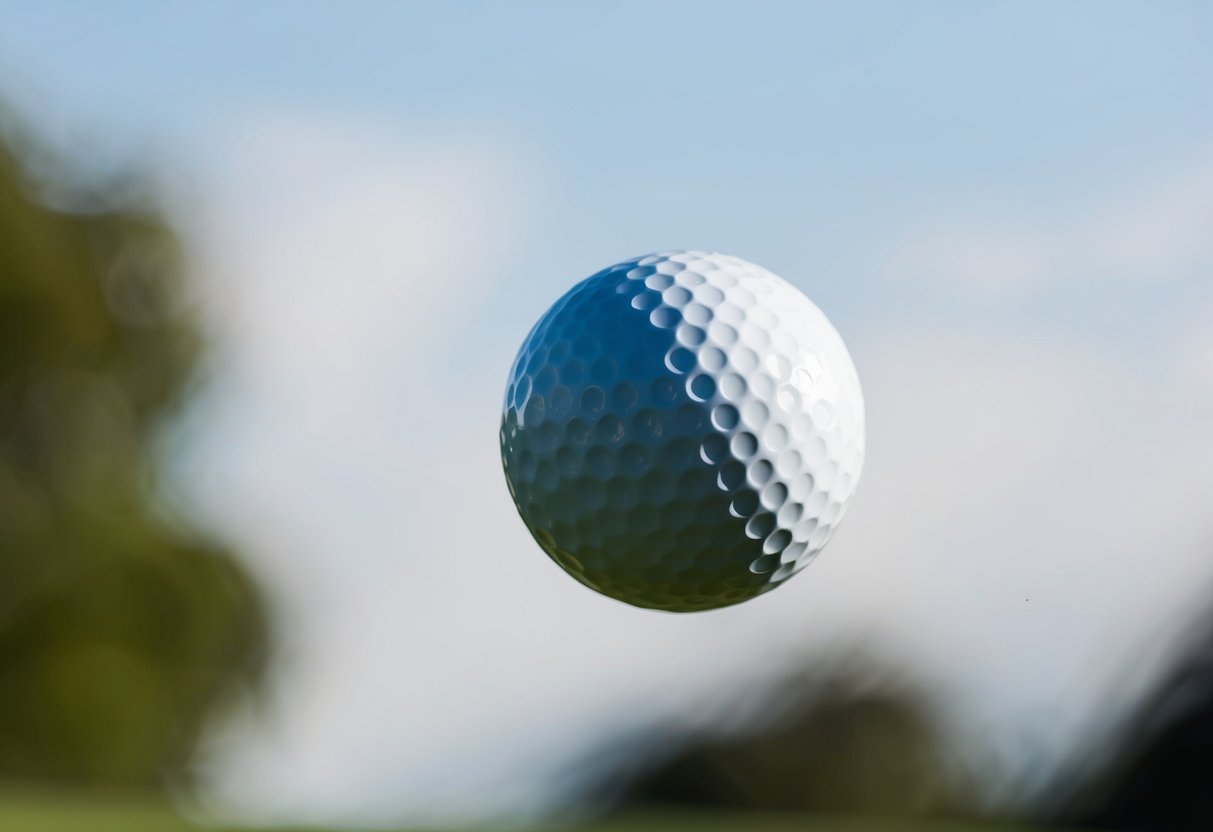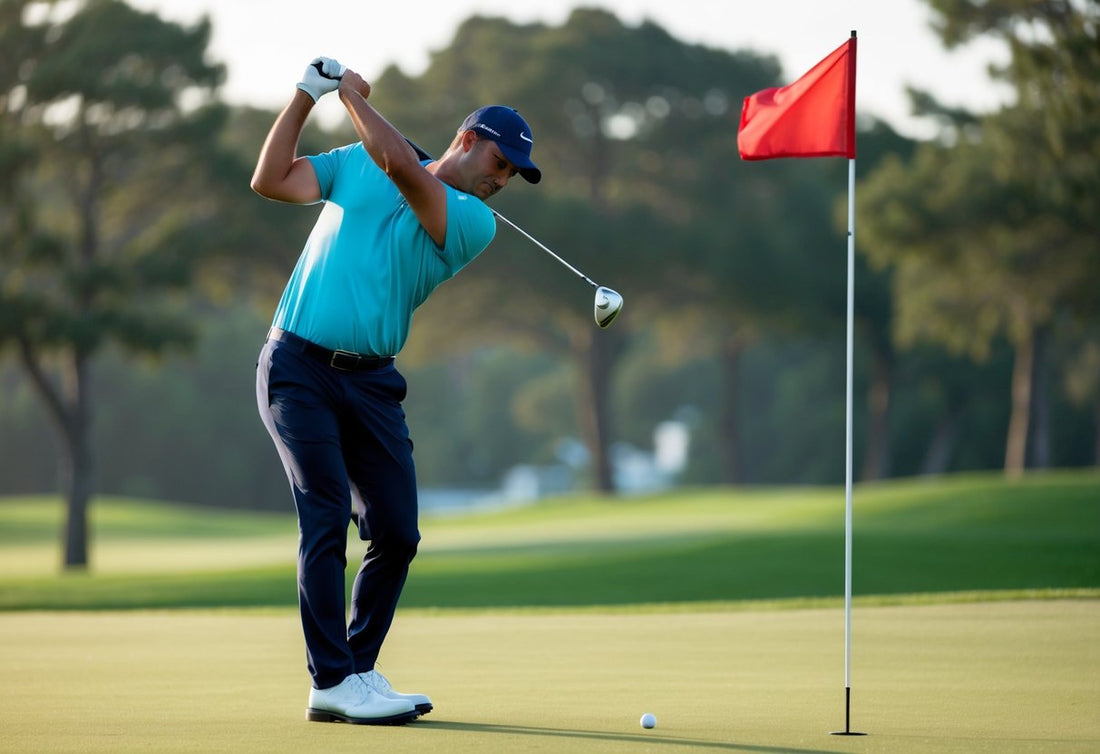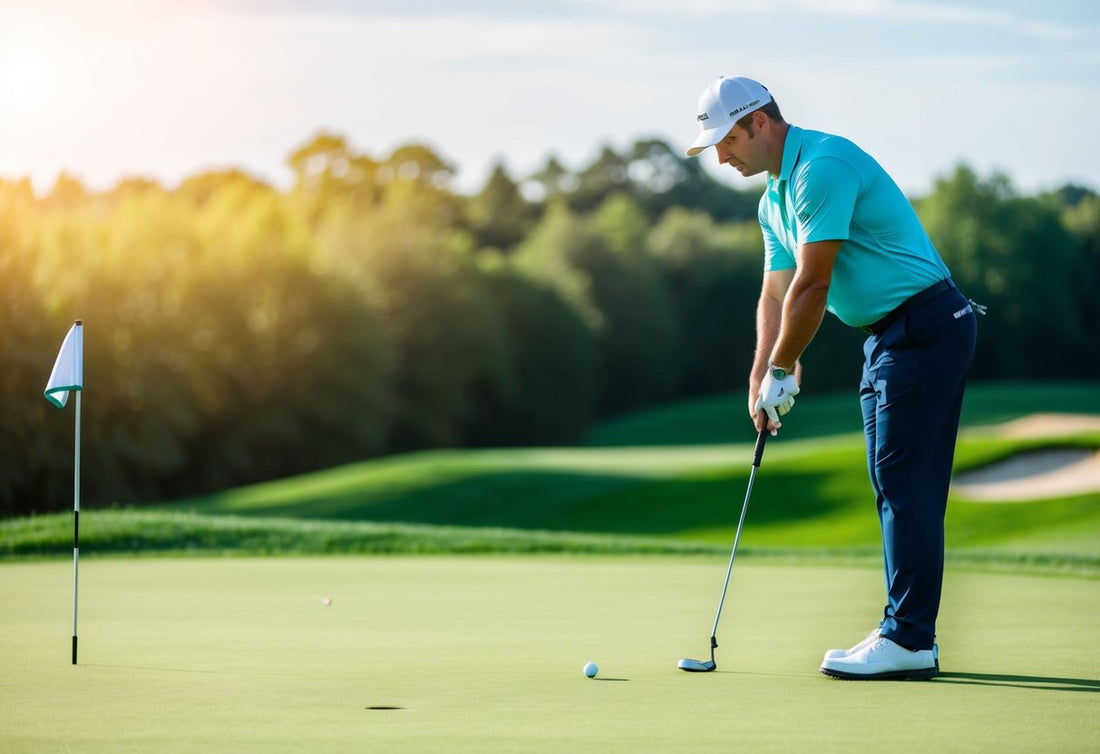Check out our golf rangefinders by Vovex to elevate your game!
Golf balls are fascinating feats of engineering. Those tiny dimples covering the surface aren't just for show - they play a crucial role in how the ball flies through the air. The dimples on a golf ball create a thin layer of air that clings to the ball's surface, reducing drag and allowing it to travel farther.
We've all seen professional golfers drive balls incredible distances. While skill and technique are important, the dimples are working their magic behind the scenes. They help the ball maintain lift, stabilize its flight path, and even influence spin rates.
Ever wonder why golf balls look the way they do? It's all about aerodynamics. The dimple pattern disrupts the airflow around the ball, creating a complex interaction between the ball and the atmosphere. This seemingly simple design feature has a profound impact on performance.
Key Takeaways
- Dimples reduce air resistance, allowing golf balls to travel farther
- The pattern and depth of dimples affect ball flight stability and spin
- Golf ball design continues to evolve, optimizing dimple configurations for better performance
The Role of Dimples in Golf Ball Aerodynamics
Dimples on golf balls play a crucial role in their flight dynamics. We've discovered that these tiny indentations significantly reduce air resistance, allowing the ball to travel farther.
When a smooth ball travels through the air, it creates a large wake behind it. This wake increases drag and slows the ball down quickly. Dimples change this behavior dramatically.
The dimples create a thin layer of air that clings to the ball's surface. This layer, known as the boundary layer, helps the air flow more smoothly around the ball. As a result, the wake behind the ball becomes much smaller.
Here's how dimples affect a golf ball's flight:
- Reduce drag by up to 50%
- Increase lift forces
- Allow for greater distance and accuracy
- Enable better control of trajectory
The size, shape, and pattern of dimples all influence performance. Most golf balls have between 300 and 500 dimples, with depths ranging from 0.004 to 0.010 inches.
We've found that dimples also help maintain spin during flight. This spin generates lift, keeping the ball in the air longer. It's why professional golfers can achieve those impressive long drives.
Physics of Golf Balls in Flight
Golf ball aerodynamics involve complex interactions between the ball's surface and the air it travels through. These forces significantly impact the ball's trajectory and distance.
Drag and Lift Forces
Drag force acts opposite to the ball's motion, slowing it down. As the ball flies, it creates a pressure difference between its front and back. This difference results in drag, which reduces the ball's speed and distance.
Lift force, on the other hand, counteracts gravity and keeps the ball airborne longer. It's generated by the ball's spin and the air flowing around it. The faster the spin, the more lift is produced.
We've found that the dimples on a golf ball play a crucial role in managing these forces. They help create a thin layer of air that clings to the ball's surface, reducing drag and enhancing lift.
Turbulent Flow vs. Laminar Flow
Golf balls experience two types of airflow: laminar and turbulent. Laminar flow is smooth and predictable, while turbulent flow is chaotic and unpredictable.
Dimples on a golf ball promote turbulent flow, which might seem counterintuitive. However, turbulent flow actually helps the ball travel farther. It creates a smaller wake behind the ball, reducing drag.
In contrast, a smooth ball would experience laminar flow, separating from the surface earlier. This separation creates a larger wake and more drag, resulting in shorter flight distances.
We've observed that the size, depth, and pattern of dimples all affect how they influence airflow. Golf ball manufacturers carefully design these features to optimize performance.
Evolution of Golf Ball Design
Golf ball design has come a long way since the early days of the sport. The progression from smooth to dimpled surfaces revolutionized how golf balls fly through the air.
From Smooth to Dimpled
The first golf balls were smooth leather spheres filled with feathers. In the mid-1800s, gutta-percha balls took over. Players soon noticed that scuffed balls flew farther and straighter.
This discovery led to intentionally nicked surfaces. Manufacturers began experimenting with different patterns. By the early 1900s, dimples became the standard.
We saw rapid innovation in dimple designs. Companies tested various shapes, sizes, and arrangements. The goal was to find the optimal aerodynamic properties.
Influence on Modern Golf
Today's golf balls feature precisely engineered dimple patterns. These designs maximize lift and minimize drag, allowing for greater distance and accuracy.
High-speed cameras and wind tunnels help refine dimple configurations. We've seen the emergence of hybrid dimples, combining different shapes and depths.
Modern golf balls also utilize advanced materials in their cores and covers. This further enhances performance when paired with optimized dimple patterns.
The evolution of golf ball design has significantly impacted the game. Players can now achieve distances that were once unimaginable. It's changed course layouts and playing strategies across the sport.
Dimple Pattern Variations
Golf ball dimple patterns come in a wide variety of designs. We've found that manufacturers experiment with different shapes, sizes, and arrangements to optimize ball flight characteristics.
Effects of Different Dimple Designs
Circular dimples are the most common, but we've seen hexagonal, pentagonal, and even teardrop shapes used. Shallow dimples tend to produce lower ball flight with more roll, while deeper dimples generate higher trajectories and more lift.
Some balls feature larger dimples around the equator and smaller ones at the poles. This design aims to reduce drag during the initial launch phase. We've noticed that varying dimple depth across the ball's surface can also influence spin rates and stability in flight.
Optimizing Dimple Patterns for Performance
Golf ball engineers use advanced computer simulations and wind tunnel testing to fine-tune dimple patterns. We've learned that the total number of dimples, typically ranging from 300 to 500, plays a crucial role in performance.
The arrangement of dimples is equally important. Symmetrical patterns help maintain consistent flight regardless of the ball's orientation at impact. Some high-performance balls incorporate multiple dimple sizes in complex arrangements to optimize aerodynamics.
Dimple edge angles and surface coverage percentage are other key factors. Sharper edges can increase lift, while higher coverage reduces air resistance. We've seen that finding the right balance is essential for maximizing distance and control.
Material and Structure Impact on Flight Path
The materials and construction of a golf ball play a crucial role in how it interacts with air during flight. These factors work in tandem with dimples to influence trajectory and distance.
Construction of the Golf Ball
Golf balls have come a long way since the early days of stuffed leather pouches. Modern balls typically feature a multi-layer design. The core is usually made of rubber or synthetic materials, surrounded by one or more mantle layers.
The outer cover is typically crafted from urethane or Surlyn. Urethane covers offer better spin control and feel, while Surlyn provides increased durability. The combination of these layers affects the ball's compression, which in turn impacts its flight characteristics.
Different core densities and mantle materials can alter a ball's initial velocity off the clubface. This initial speed, combined with the dimple pattern, determines how far and accurately the ball will travel.
Interaction of Material with Dimples
The material of the golf ball's cover interacts closely with its dimple pattern to affect air flow. A softer cover material, like urethane, can deform slightly upon impact, potentially enhancing the dimple effect.
This deformation can create a more pronounced dimple edge, leading to better air separation and reduced drag. Harder covers, while more durable, may not provide the same level of interaction with the dimples.
The surface texture of the cover also plays a role. A slightly rougher texture can help maintain the turbulent boundary layer created by dimples, especially in wet conditions. This helps the ball maintain its aerodynamic properties even when moisture is present on its surface.
Scientific Studies on Golf Ball Trajectories
We've seen fascinating research on how dimples affect golf ball flight. In 2016, a study published in the Journal of Fluid Mechanics used wind tunnel experiments to analyze dimple patterns.
The researchers found that dimples create a thin layer of air around the ball, reducing drag. This layer, called the boundary layer, helps the ball travel farther.
Another study in 2018 used high-speed cameras and computer simulations. It revealed that dimples also influence lift forces on the ball during flight.
We discovered that deeper dimples generally produce more lift but increase drag. Shallower dimples reduce drag but provide less lift. It's a delicate balance!
A 2020 study in Sports Engineering compared various dimple shapes:
| Shape | Effect on Flight |
|---|---|
| Circular | Balanced lift and drag |
| Hexagonal | Increased lift, slightly more drag |
| Truncated | Reduced drag, less lift |
These findings help golf ball manufacturers optimize their designs. By tweaking dimple patterns, they can create balls with specific flight characteristics.
Recent research has also explored asymmetrical dimple patterns. These designs aim to correct common swing flaws and improve overall performance for amateur golfers.
Technological Innovations in Golf Ball Manufacturing
Golf ball manufacturing has come a long way in recent years. We've seen remarkable advancements that have revolutionized how these crucial pieces of equipment are produced.
One major innovation is the use of computer-aided design (CAD) software. This technology allows manufacturers to create precise dimple patterns and optimize ball aerodynamics before production even begins.
3D printing has also made its mark on golf ball production. We can now rapidly prototype new designs and test different materials with unprecedented speed and accuracy.
Advanced materials science has given us new core compositions. Multi-layer balls with specialized inner cores offer improved energy transfer and spin control.
Robotics and automation have streamlined the manufacturing process. Machines now handle tasks like core centering and dimple application with incredible precision.
Here's a quick look at some key innovations:
| Innovation | Benefit |
|---|---|
| CAD Software | Optimized dimple designs |
| 3D Printing | Rapid prototyping |
| New Materials | Enhanced performance |
| Robotics | Improved consistency |
These technological leaps have led to golf balls that fly farther, spin more predictably, and offer better control than ever before. We're excited to see what the future holds for golf ball manufacturing as technology continues to evolve.
Practical Tips for Golfers
Choosing the right golf ball and adapting to environmental factors can significantly impact your game. Let's explore some key strategies to optimize your performance on the course.
Choosing the Right Golf Ball
We recommend testing different golf ball types to find the best fit for your game. Low-handicap players often prefer balls with a softer feel and more spin control. High-handicap golfers might benefit from distance-oriented balls with a harder cover.
Consider your swing speed when selecting a ball. Faster swingers can compress firmer balls more effectively, while slower swingers may see better results with softer balls.
Don't overlook the importance of dimple patterns. Balls with shallower dimples tend to fly higher, which can be advantageous in calm conditions. Deeper dimples can help maintain stability in windy weather.
Adapting to Environmental Factors
Wind is a crucial factor to consider when playing golf. We suggest using lower-trajectory shots in headwinds to minimize lift. In tailwinds, a higher ball flight can maximize distance.
Temperature affects ball performance too. In colder weather, golf balls don't compress as much, potentially reducing distance. We recommend storing balls in a warm place before play in chilly conditions.
Altitude changes can also impact ball flight. At higher elevations, the thinner air reduces drag, potentially increasing distance. Adjust your club selection accordingly when playing at different altitudes.
Lastly, consider the course conditions. On softer fairways, choose a ball with less spin to prevent excessive digging. For firmer surfaces, a ball with more spin can provide better control.
Frequently Asked Questions
Dimples play a crucial role in golf ball aerodynamics and performance. Let's explore some common questions about their impact on flight paths.
Why do golf balls have dimples?
Golf balls have dimples to reduce air resistance during flight. These small indentations create a thin layer of air that clings to the ball's surface, allowing it to travel farther and more accurately.
Can the number of dimples on a golf ball influence its flight?
The number of dimples can indeed affect a golf ball's flight. Most golf balls have between 300 and 500 dimples. Generally, more dimples can lead to higher ball flight and increased lift.
What role do dimples play in golf ball aerodynamics?
Dimples create turbulence in the air around the ball as it flies. This turbulent layer helps the ball maintain its speed and trajectory, resulting in longer distances and more stable flight paths.
Do dimples on golf balls help with increasing speed by reducing drag?
Yes, dimples on golf balls do increase speed by reducing drag. They create a smaller wake behind the ball, allowing it to maintain velocity for longer periods during flight.
What is the effect of different dimple designs on a golf ball's aerodynamics?
Dimple designs can vary in shape, size, and depth. Shallower dimples tend to create a higher ball flight, while deeper dimples can result in a lower trajectory. Some balls use a mix of dimple sizes for optimal performance.
How do dimples contribute to the control and distance of a golf ball flight?
Dimples enhance both control and distance by stabilizing the ball's flight path. They help maintain spin rates, which is crucial for achieving desired shot shapes and distances on the golf course.






